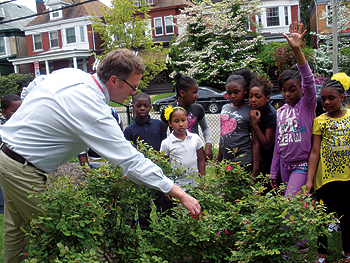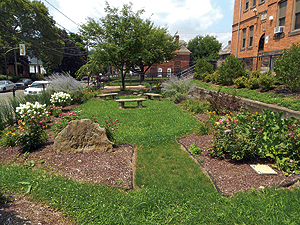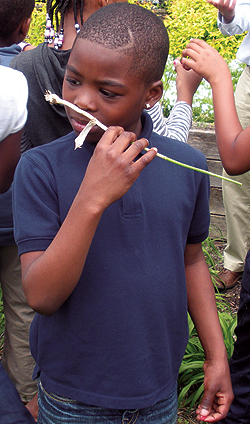Bringing Science to Life: WPC Professionals Connect with Students
About 20 kindergarteners clutching crayons and slips of paper sat on tree stumps and rocks in a Pittsburgh elementary school’s natural play space and pondered a big question.

Ephraim Zimmerman, an ecologist at the Conservancy, interacts with students at Fulton Elementary School’s Nature Yard.
If you were a bug, where would you hide?
It didn’t take long for hands to shoot in the air and for the answers to come in rapid fire. “In a rose,” shouted a girl. “Under a rock,” asserted a boy. Soon, the children took to their paper, eagerly sketching their ideas and signing their art.
It had been a busy day at the Pittsburgh Roosevelt PreK-1 campus. The five- and six-year-olds dug up earthworms and examined them under plastic magnifying glasses before returning them to their muddy home. They tickled pill bugs until the rolly pollies recoiled into balls on the kids’ palms. And the children closed their eyes and listened – really listened – to the rustling leaves, rumbling distant traffic, chirping birds and other sounds around them.
Roosevelt students aren’t strangers to the school’s green space. The children enjoy the natural play space, but this is one of the first times the boys and girls used their play space as an outdoor laboratory with the help of the Western Pennsylvania Conservancy’s Scientists in the Schools pilot project.
Conservancy staff coordinated and participated in the pilot project, a program that introduces Pittsburgh-area school students to WPC ecologists, botanists, bryologists and other scientists and encourages children to explore science through interactive activities. In all, WPC staff reached out to hundreds of elementary students in Pittsburgh’s Roosevelt and Fulton schools during the last school year. Nyya Jones, a community outreach assistant at the Conservancy, said the teachers were excited and the kids were engaged. She believes there is potential for WPC to offer more learning opportunities like these to students and teachers in the future.

Fulton Elementary School’s Nature Yard
“The green spaces give the kids – specifically, children who live in urban settings – a chance to see, touch and connect with nature. The Scientists in the Schools component allows them to consider options and careers they might not have thought about before,” Jones said. “For example, by the end of one session, the students learned that bryologists study and were able to locate and identify moss growing in their green space.”
This is part of the Conservancy’s ongoing effort to reach out to schools and students in in Pittsburgh and across Western Pennsylvania. Various WPC scientists and other professionals routinely visit public schools and offer educational programs. For example, members of the Conservancy’s Watershed Conservation Program have made routine visits to an Indiana County high school over the last decade, teaching the scientific method, demonstrating water sampling and conducting other activities. Watershed staff members also take assorted critters to nearby preschools.
Among other activities, Fallingwater provides the Wright In Our Backyard program, which offers free house tours to elementary through high school students and funds for bus transportation to public schools in Fayette, Greene, Somerset, Washington and Westmoreland counties. More than 15,000 students have participated in tours of Fallingwater and associated interactive workshops through this program.
Through the Scientists in the Schools program, WPC is working to help bring projects full circle. Fulton Elementary School, for example, received 19 trees and more than 300 shrubs and perennials through WPC’s School Grounds Greening project for its preexisting Nature Yard.

A student at Fulton Elementary School takes in the sights and smells of the school’s Nature Yard.
“Parents really got this off and running for us. They thought that this space could be better used and they helped us contact the Western Pennsylvania Conservancy,” said Kevin Bivins, Fulton’s principal.
The school, located in the Highland Park neighborhood of Pittsburgh, was the first school to respond when the Conservancy advertised the Scientists in Schools program in a quarterly newsletter.
Last spring WPC scientists Christopher Tracey and Pete Woods visited the Nature Yard and spoke about the differences between wild plants and cultivated plants. Using wild onions and garlic mustard growing in the school’s green space as an example, they discussed with the class some of the techniques that scientists use to identify plants in the wild. The class then talked about the importance of native species and the impact of invasive plants.
WPC staff worked with teachers throughout the planning process to ensure that each activity was tailored and grade-level appropriate. These interactive sessions used the greenery planted on the school grounds as examples, along with materials that scientists use in the field every day. The project leveraged the in-depth knowledge of WPC’s ecologists and botanists to bring outdoor learning to life.
At another event, WPC field staff took fourth-grade students on a walk around Fulton’s Nature Yard to identify plants such as star magnolias, creeping phlox, a weeping cherry tree and a paperbark maple. The students were studying the food chain in science class, so WPC staff discussed what adaptations plants might have in order to avoid becoming food. The thorned roses in the Nature Yard were used as a case study.
WPC ecologist Ephraim Zimmerman talked to a third-grade class about what plants and soil do for each other, what weeds are and how weeds can affect the soil quality for other plants. Students examined plants preserved in a plant press and talked about why scientists collect the type of plants they do.
Most days ended with a nature-based scavenger hunt that prompted students to find a plant that was fragrant, listen to a sound made by nature and locate a spot that an animal or insect could use to hide.
